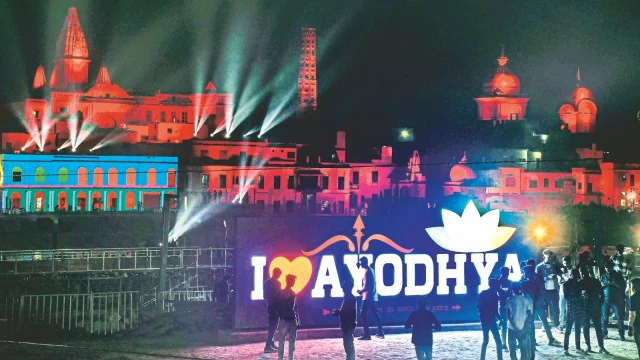The recently released revised NCERT Class 12 Political Science textbook omits all mention of the Babri Masjid, referring to it only as a “three-domed structure.” It also reduces the Ayodhya section from four to two pages and omits important elements from the previous edition.
These include the BJP’s “regret over the happenings at Ayodhya,” the president’s rule in states where the party is in power, the BJP’s rath yatra from Somnath in Gujarat to Ayodhya, the function of kar sevaks, and sectarian rioting that followed the destruction of the Babri Masjid on December 6, 1992.
The NCERT revealed some of the modifications, including the elimination of at least three references to the demolition and the elevation of the Ram Janmabhoomi campaign, as The Indian Express reported on April 5. However, up until today, the breadth of the alterations was unknown.
Also Read NEET UG 2024 Paper Leak: Supreme Court Told Centre To Re-Exam!
The key changes:
- The old textbook introduces Babri Masjid as a 16th-century mosque built by Mughal emperor Babur’s General Mir Baqi. Now, the chapter refers to it as “a three-dome structure (that) was built at the site of Shri Ram’s birthplace in 1528, but the structure had visible displays of Hindu symbols and relics in its interior as well as its exterior portions”.
- The old textbook, which took up more than two pages, talked of the mobilization “on both sides” when the masjid’s locks were unlocked in February 1986 per the district court of Faizabad (now Ayodhya) orders. It discussed tensions within the community, the planned rath yatra from Somnath to Ayodhya, the volunteer work done in December 1992 to construct the Ram Temple, the mosque’s demolition, and the ensuing violence within the community in January 1993. The BJP’s “regret over the happenings at Ayodhya” and reference to the “serious debate over secularism” were mentioned.
- This has been replaced with a paragraph: “In 1986, the situation regarding the three-dome structure took a significant turn when the Faizabad (now Ayodhya) district court ruled to unlock the structure, allowing people to worship there. The dispute had been going on for many decades as it was believed that the three-dome structure was built at Shri Ram’s birthplace after demolition of a temple. However, although Shilaanyas for the temple was done, further construction remained prohibited. The Hindu community felt that their concerns related to the birth place of Shri Ram were overlooked, while the Muslim community sought assurance of their possession over the structure. Subsequently, tensions heightened between both communities over ownership rights, resulting in numerous disputes and legal conflicts. Both communities desired a fair resolution to the longstanding issue. In 1992, following the demolition of the structure, some critics contended that it presented a substantial challenge to the principles of Indian democracy.”
- A subsection on the Supreme Court’s decision on the Ayodhya dispute (titled ‘From Legal Proceedings to Amicable Acceptance’) has been added in the new version of the textbook. This states that “in any society, conflicts are bound to take place”, but “in a multi-religious and multicultural democratic society, these conflicts are usually resolved following the due process of law”. It then mentions the 5-0 verdict of the Constitutional bench of the Supreme Court on November 9, 2019, on the Ayodhya dispute. That verdict set the stage for the temple – which was inaugurated in January this year.
- “The verdict allotted the disputed site to the Shri Ram Janmabhoomi Teertha Kshetra Trust for the construction of Ram temple and directed the concerned government to allot the appropriate site for the construction of a Mosque to the Sunni Central Waqf Board. In this way, democracy gives room for conflict resolution in a plural society like ours, upholding the inclusive spirit of the Constitution. This issue was resolved following the due process of law based on evidence such as archaeological excavations and historical records. The Supreme Court’s decision was celebrated by the society at large. It is a classic example of consensus building on a sensitive issue that shows the maturity of democratic ethos which are civilizationally ingrained in India,” the textbook states.
- The outdated textbook included pictures of media clippings, one titled “Babri Masjid demolished, Centre sacks Kalyan Govt.” from December 7, 1992. Atal Bihar Vajpayee, the former prime minister, is quoted in another headline from December 13, 1992, referring to Ayodhya BJP’s “worst miscalculation.” Now, every newspaper clipping has been removed.
- In the case of Mohd. Aslam v. Union of India, on October 24, 1994, the then-chief justice Venkatachaliah and justice G N Ray of the Supreme Court found Kalyan Singh, the chief minister of Uttar Pradesh on the day of the demolition, guilty of contempt of court for his failure to “uphold the majesty of law,” according to an excerpt found in the old book. Furthermore, “we also sentence him to a token imprisonment of one day since the contempt raises larger issues which affect the very foundation of the secular fabric of our nation.”
Also Read JoSAA 2024 Counselling Dates Announced: See The Official Schedule Here!
This has now been replaced with an excerpt from the Supreme Court verdict of November 9, 2019 which states: “…Every judge of this Court is not merely tasked with but sworn to uphold the Constitution and its values. The Constitution does not make a distinction between the faith and belief of one religion and another. All forms of belief, worship and prayer are equal…It is thus concluded … that faith and belief of Hindus since prior to construction of Mosque and subsequent thereto has always been that Janmaasthan of Lord Ram is the place where Babri Mosque has been constructed which faith and belief is proved by documentary and oral evidence.”
This is the fourth round of revision and updating of NCERT textbooks since 2014. Referring to the changes to the section on Ayodhya, the NCERT had said in April: “Content is updated as per latest development in politics. Text on Ayodhya issue has been thoroughly revised because of the latest changes brought by the Supreme Court’s Constitutional bench verdict and its widespread welcoming reception.”
Stay Connected With us: siasatpro.com



Recent Comments